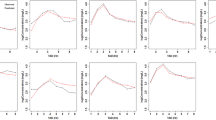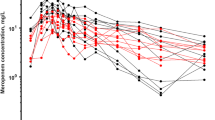Abstract
The pharmacokinetics of pefloxacin (PF) were investigated in a population of 74 intensive care unit patients receiving 400 mg bid as 1-hr infusion using (i) Bayesian estimation (BE) of individual patient parameters followed by multiple linear regression (MLR) analysis and (ii) NONMEM analysis. The data consisted of 3 to 9 PF plasma levels per patient measured over 1 to 3 dosage intervals (total 113) according to four different limited (suboptimal) sampling 3-point protocols. Twenty-nine covariates (including 15 comedications) were considered to explain the interpatient variability. Predicted PFCLfor a patient with median covariates values was similar in both BE/ MLR and NONMEM analysis (4.02 and 3.92 L/hr, respectively). Bilirubin level and age were identified as the major determinants of PFCLby both approaches with similar predicted magnitude of effects (about 40 and 30% decrease of median CL,respectively). Confounding effects were observed between creatinine clearance (26% decrease of PF CLin the BE/MLR model), simplified acute physiology score (a global score based on 14 biological and clinical variables) (18% decrease of median CLin the NONMEM model) and age (entered in both models) which were highly correlated in our data base. However, both models predicted similar PF CLfor actual subpopulations by using actual covariate values. Finally, the NONMEM analysis allowed identification of an effect of weight on CL(decrease of CL for weight <65 kg) whereas the BE/MLR analysis predicted an increase of CLin patients treated with phenobarbital. In conclusion, both approaches allowed identification of the major risk factors of PF pharmacokinetics in ICU patients. Their potential use at different stages of drug development is discussed.
Similar content being viewed by others
References
L. B. Sheiner, B. Rosenberg, and V. V. Marathe. Estimation of population characteristics of pharmacokinetic parameters from routine clinical data.J. Pharmacokin. Biopharm. 5:445–479 (1977).
L. B. Sheiner and T. H. Grasela. An Introduction to mixed effect modeling: concepts, definitions and justification.J. Pharmacokin. Biopharm. 19(Suppl.):11–24 (1991).
L. B. Sheiner. Population approach in drug development: rationale and basic concepts. In M. Rowland and L. Aarons (eds.),New Strategies in Drug Development and Clinical Evaluation: The Population Approach, Commission of European Communities, Brussels, 1992, pp. 13–29.
R. Temple. The clinical investigation of drugs for use by the elderly: Food and drug guidelines.Clin. Pharmacol. Ther. 42:681–685 (1987).
C. C. Peck. Population approach in pharmacokinetics and pharmacodynamics: FDA view. In M. Rowland and L. Aarons (eds.),New Strategies in Drug Development and Clinical Evaluation: The Population Approach, Commission of European Communities, Brussels, 1992, pp. 157–168.
L. B. Sheiner and L. Z. Benet. Premarketing observational studies of population pharmacokinetics of new drugs.Clin. Pharmacol. Ther. 38:481–487 (1985).
W. A. Colburn. Controversy IV: Population pharmacokinetics, NONMEM and the pharmacokinetic screen; Academic, industrial and regulatory perspectives.J. Clin. Pharmacol. 29:1–6 (1989).
M. E. Sale and T. F. Blaschke. Incorporating pharmacokinetic/pharmacodynamic modeling in drug development-are we ready?Drug Information J. 26:119–124 (1992).
R. Jochemsen. Current experience of population pharmacokinetics within the pharma-ceutical industry: An introduction. In M. Rowland and L. Aarons (eds.),New Strategies in Drug Development and Clinical Evaluation: The Population Approach, Commission of European Communities, Brussels, 1992, pp. 127–130.
S. L. Beal and L. B. Sheiner.NONMEM User's Guide, University of California at San Francisco, San Francisco.
J. L. Steimer. Population models and methods, with emphasis on pharmacokinetics. In M. Rowland and L. Aarons (eds.),New Strategies in Drug Development and Clinical Evaluation: The Population Approach, Commission of European Communities, Brussels, 1992, pp. 31–40.
R. Bruno, P. Rosier, A. Iliadis, Y. Le Roux, G. Montay, A. Frydman, and J. Gaillot. Evaluation of Bayesian estimation to discriminate subpopulations of patients with altered pharmacokinetics using fragmentary data: A pilot study with pefloxacin.Eur. J. Pharmacokin. Drug Metab. Special Issue No. 3:338–345 (1992).
J. P. Gonzalez and J. M. Henwood. Pefloxacin. A review of its antibacterial activity, pharmacokinetic properties and therapeutic use.Drugs 37:628–668 (1989).
M. C. Launay-Iliadis. Elaboration d'un protocole optimal en pharmacocinétique clinique: Application à des anti-cancéreux. Ph.D. thesis, Aix-Marseille University (1989).
Y. Hashimoto and L. B. Sheiner. Designs for population pharmacodynamics: Value of pharmacokinetic data and population analysis.J. Pharmacokin. Biopharm. 19:333–353 (1991).
G. Montay and J. P. Tassel. Improved high-performance liquid Chromatographic determination of pefloxacin and its main active metabolite in human plasma or tissue.J. Chromatog. 339:214–218 (1985).
J. R. Le Gall, P. Loirat, A. Alperovitch, P. Glaser, C. Granthil, D. Mathieu, P. Mercier, R. Thomas, and D. Villers. A simplified acute physiology score for ICU patients.Crit. Care Med. 12:975–977 (1984).
A. Frydman, Y. Le Roux, M. A. Lefebvre, F. Djebbar, J. E. Fourtillan, and J. Gaillot. Pharmacokinetics of pefloxacin after repeated intravenous and oral administration (400 mg b.i.d.) in young healthy volunteers.J. Antimicrob. Chemother. 17(Suppl.B): 65–79 (1986).
A. Iliadis, M. Bachir-Raho, R. Bruno, and R. Favre. Bayesian estimation and prediction of clearance in high-dose methotrexate infusion.J. Pharmacokin. Biopharm. 13:101–115 (1985).
A. Iliadis.APIS User's Guide, Loginserm Copyright INSERM 1987, A. Iliadis/MIIPS.
R. R. Hocking. The analysis and selection of variables in linear regression.Biometrics 32:1–49 (1976).
D. F. Morrison.Multivariate Statistical Methods, 2nd ed., McGraw-Hill, New York (1976).
L. Lebart, A. Morineau, and T. Lambert. SPAD.N, CISIA, Paris (1989).
SAS/STAT User's Guide, Version 6. SAS Institute Inc., Cary, NC (1990).
J. W. Mandema, D. Verotta, and L. B. Sheiner. Building population pharmacokinetic-pharmacodynamic models. I. Models for covariate effects.J. Pharmacokin. Biopharm. 20:511–529 (1992).
E. Sultan, C. Richard, M. Pezzano, P. Auzepy, and E. Singlas. Pharmacokinetics of pefloxacin and amikacin administered simultaneously to intensive care patients.Eur. J. Clin. Pharmacol 34:637–643 (1988).
G. Danan, G. Montay, R. Cunci, and S. Erlinger. Pefloxacin kinetics in cirrhosis.Clin. Pharmacol. Ther. 38:439–442 (1985).
J. Dow, A. M. Frydman, F. Djebbar, and J. Gaillot. Singleand multiple-dose pharmacokinetics of pefloxacin in elderly patients.Rev. Infect. Dis. Suppl. 1:S107 (1988).
G. Montay, C. Jacquot, J. Bariety, and R. Cunci. Pharmacokinetics of pefloxacin in renal insufficiency.Eur. J. Clin. Pharmacol. 29:345–349 (1985).
P. Jüngers, D. Ganeval, T. Hannedouche, B. Prieur, and G. Montay. Steady-state levels of pefloxacin and its metabolites in patients with severe renal impairment.Eur. J. Clin. Pharmacol. 33:463–467 (1987).
D. Höffler, I. SchÄfer, P. Koeppe, and F. Sörgel. Pharmacokinetics of pefloxacin in normal and impaired renal function.Arzneim. Forsch./Drug Res. 38(1):739–743 (1988).
Y. Le Roux, G. Montay, A. Frydman, and J. Gaillot. Facteurs de variabilité interindivid-uelle de la pharmacocinétique de la péfloxacine dans l'insuffisance rénale. In J. Bres and G. Panis (eds.),IntérÊt et Limites de la Pharmacocinétique en Recherche et Développement. Troisiémes Journées Méditerranéenees de Pharmacocinétique, Sauramps Médical, Montpellier, 1988, pp. 652–657.
G. Humbert, I. Brumpt, G. Montay, A. Le Liboux, A. Frydman, F. Borsa-Lebas and N. Moore. Influence of rifampin on the pharmacokinetics of pefloxacin.Clin. Pharmacol. Ther. 50:682–687 (1991).
P. O. Maitre, M. Bührer, D. Thomson, and D. R. Stanski. A three-step approach combining Bayesian regression and NONMEM population analysis: Application to midazolam.J. Pharmacokin. Biopharm. 19:377–384 (1991).
Author information
Authors and Affiliations
Rights and permissions
About this article
Cite this article
Bruno, R., Iliadis, MC., Lacarelle, B. et al. Evaluation of Bayesian estimation in comparison to NONMEM for population pharmacokinetic data analysis: Application to pefloxacin in intensive care unit patients. Journal of Pharmacokinetics and Biopharmaceutics 20, 653–669 (1992). https://doi.org/10.1007/BF01064424
Received:
Revised:
Published:
Issue Date:
DOI: https://doi.org/10.1007/BF01064424




